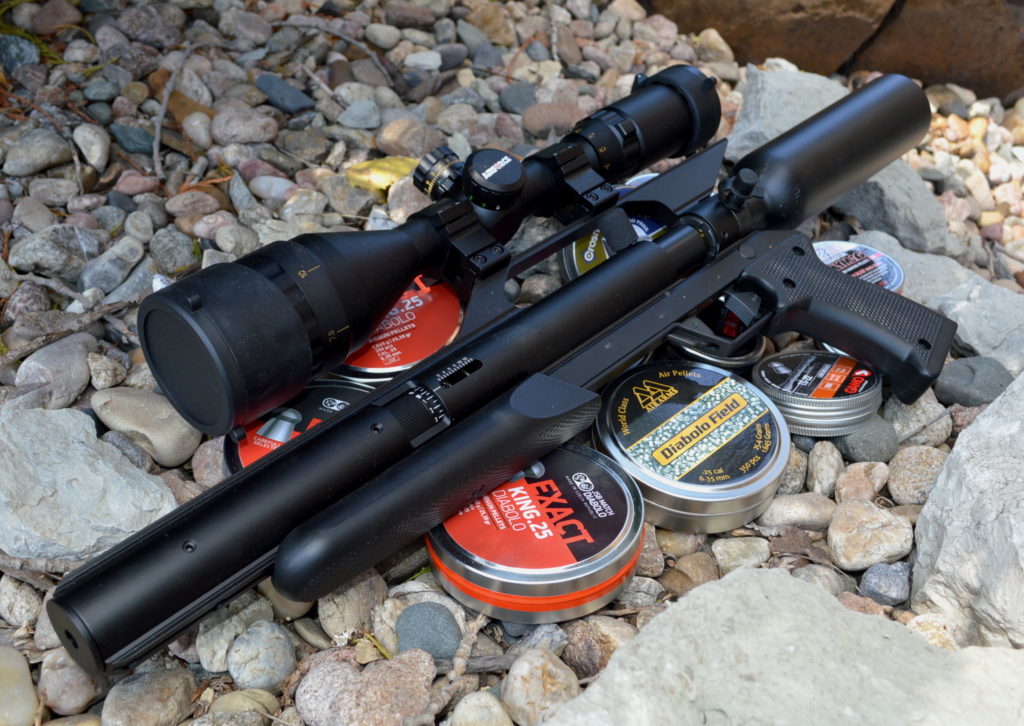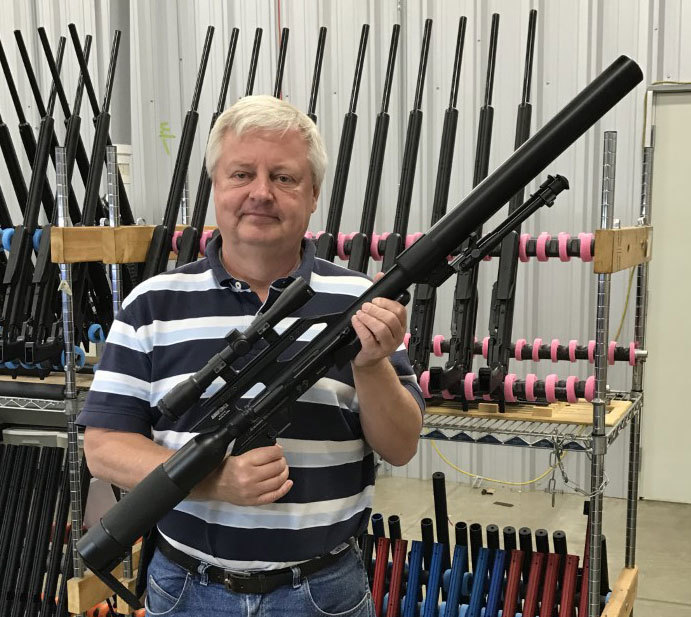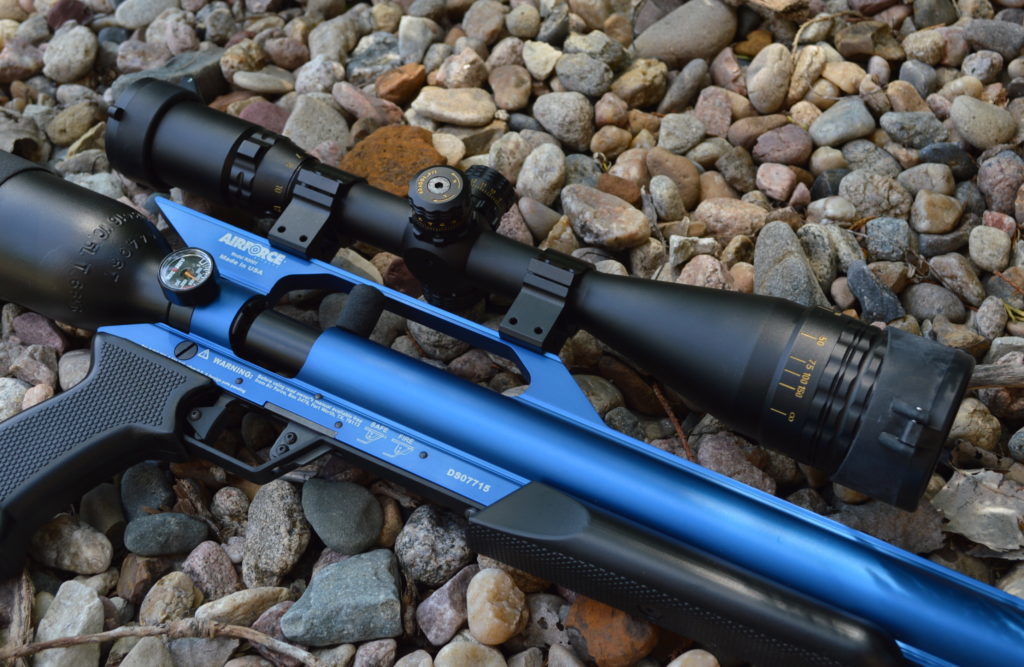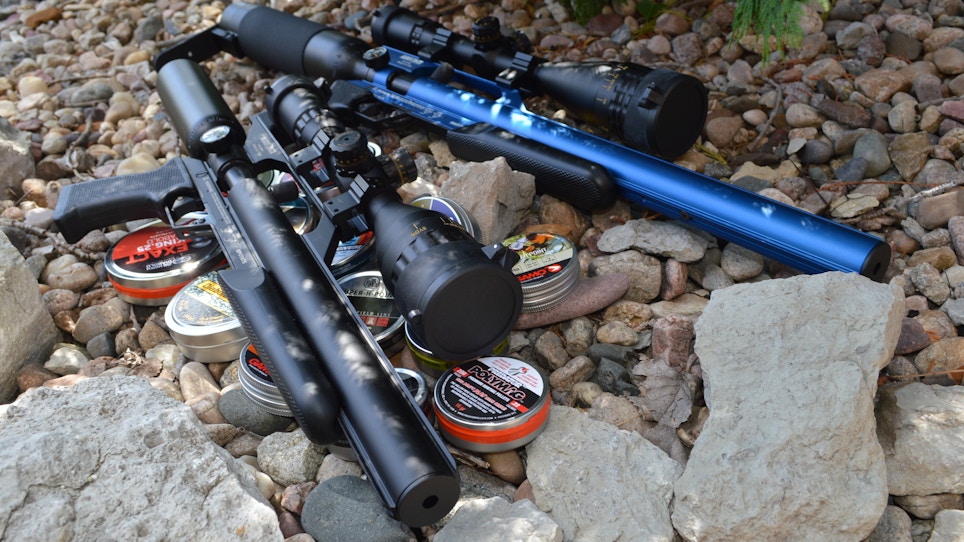Airforce Airguns was founded in the 1990s and is known as the first American manufacturer to offer suppressed air rifles to the U.S. market. The company currently offers pellet guns in big bore, utility and target models across a range of .177, .20, 22, .357, .30, .45 calibers. Most models can quickly swap calibers and barrel lengths in just a few minutes. Airforce has a big bore line with the most powerful production airguns ever made delivering a stunning 500-plus ft./lbs. of energy with .45-caliber 400-plus-grain slugs. With this type of power, their big-bore airguns have no problem humanely taking game as large as deer and boar. Airforce’s PCP rifles are widely used for hunting and rodent control such as the U.S. Department of Agriculture extensive use of the TalonSS model for rodent control. Airforce recently offered a 24-inch AR-15 hunting pistol that delivers over 50 ft./lbs. of energy in a 100-yard hunting accurate design.
These Airforce pellet guns are big power paired with extreme accuracy. Historically European manufacturers have dominated the precision airgun market, but in the 1990s Airforce began offering the first American-Made PCP — pre-charged pneumatic — airguns. PCP is simply an airgun with a pre-compressed air tank reservoir attached that offers a lot of shots per refill and can be refilled with a hand pump or separate refill tank. However, PCP is not a new concept. Pumps and sealable containers have been powering primitive PCP air rifles since the 1500s.
Advanced high-power repeating .51-caliber lead ball PCP airguns date all the way back to the 1700s and were used for military sniper duties. There was even one used for Lewis and Clark’s exploration of the Americas. Similar to Airforce’s modern design, these guns featured a pre-compressed air tank as the buttstock that were re-charged with a hand pump. These PCP airguns were silent smokeless clandestine military tools that were unaffected by moisture and rain and made flintlock firearms inoperable and could deliver 20 magazine fed .41- to .51-caliber balls in under 30 seconds. Over the centuries, the popularity of PCP airguns has exploded in European countries. Thanks to the innovation and persistence of Airforce over the last 20-plus years, sales in the U.S. are catching up. For any sporting retailer, the margins are higher on these airguns and with over 90 percent of PCP airgun sales occurring online, brick and mortar retailers have a huge opportunity to service this growing shooting and hunting segment.

Airforce's .25-caliber Talon is the most powerful airpistol available. It delivers a whopping 25 ft./lbs. of energy.
Recently, Shooting Sports Retailer sat down with Airforce Airguns founder and CEO John McCaslin to discuss what his company has done in the industry.
SSR: Why are customers interested in airguns?
McCaslin: Recently the lack of availability of affordable .22LR rimfire ammo drove higher-end PCP gun sales. It usually comes down to accuracy and power. The backyard shooters want fine accuracy and the hunters want the knock down power paired with enough high precision for longer shots even out to 100 yards. The BB and pellet guns we learned to shoot on as kids pail in comparison to the technology, power and accuracy of the modern PCP airgun market. Most of those old spring and pump-up guns would deliver maybe 10 to 15 ft./lbs. of energy with just enough accuracy to connect on birds at 25 yards. Today our Airforce rifles are delivering over 500 ft./lbs. of energy with a 411-grain slug which is more power than your average 9mm round all with single-hole-capable accuracy. Even our legacy 12-inch barreled .22-caliber TalonSS model introduced back in the 1990s delivers a whopping 25 ft./lbs. of energy and around 40 ft./lbs. in our .25-caliber version.
PCP are usually more accurate due to near recoil-less design and the precision metering of air pressures, but we also use match grade Lothar Walther barrels which delivers shocking accuracy. We have good shooters who are consistently delivering ¼-inch 25-yard groups and consistently taking game at 100 yards. Customers get excited about this kind of accuracy and power.
SSR: How has urbanization changed the airgun market?
McCaslin: It has changed how we shoot and hunt. It used to be many decades ago that we could just walk out our back doors and shoot or hunt on pretty much any open land, but that has changed. With the right backstop, airguns allow us to move back outdoors inside our little back yards and still safely enjoy shooting. There are a lot of airgunners shooting safely in their basements.
Hunting has also changed. There are a lot of annexed lands inside city limits which only allow hunting with non-firearms. This urbanization of hunting has spurred a noticeable growth in SSR and airgun segments allowing legal hunting of urbanized areas. Our guns deliver the power for humane hunting of even larger game such as invasive hogs. There has also been a trend for urban micro-acreage properties which provide the airgun shooter a lot of target shooting and pest elimination opportunities.
Airguns also deliver more backyard practice-time for shooters, but customers are demanding accuracy and want to hit an aspirin 25 yards away and they want to have an airgun capable of doing it every shot. One of the big drivers for our silenced/suppressor air rifles was the rise of the urban backyard shooter. We saw an opportunity to deliver a quiet backyard gun and began offering the first “quieter” shrouded airgun and then later very quiet baffled suppressed airgun which minimizes sound disturbance to neighbors.

Airforce Airguns founder and CEO John McCaslin
SSR: It is my understanding the BATF does not regulate suppressor devices used exclusively for airguns.
McCaslin: In the 1990s it was a sticky point with the BATF when we offered the first integrally suppressed airgun, but now suppressed airguns are widely available from many manufacturers. BATF is only really concerned when a suppressor device can be easily moved onto a firearm. Our solution was a proprietary integral baffle suppressor enclosed inside our barrel shroud which cannot be used elsewhere in the firearm industry. We offer both suppressed and unsuppressed air rifles and can talk retailers through this process if they have concerns.
SSR: Why PCP over spring or pump-up air rifles?
McCaslin: PCP guns have been the choice for competitive airgun shooters globally for decades for many reasons. By design, PCP guns are usually far lighter and shorter than spring guns. PCP holds the air in a lightweight reservoir and takes pumping and refill duties off the gun. PCP does not have any springs or pistons moving around creating movement or recoil during firing like spring guns — less recoil equals higher accuracy.
The benefit shooters love the most with PCP airguns is that they can just sit down in the backyard and continuously shoot and feed pellets without having to raise the gun up and cock the gun in between each shot. For the hunter, the ability to just quickly reset the bolt drop in another pellet and fire is a critical feature. There are also convenience factors of being able to change power setting on the fly from full power to lower power based on the need and having 20 to 200 shots per refill (dependent on power setting and caliber), and then being able to just walk over to your refill tank and have a full recharge in a few seconds for more shooting.
SSR: Has there been a sales barrier to PCP vs. spring or COs?
McCaslin: It really comes down to an educational process of what PCP is and we lose a lot of people when we start talking about scuba tanks high pressure air for refills. The easiest example is that PCP is very similar to paintball — there is a tank attached to the airgun which needs to be recharged. Paintball tanks operate at a lower pressure under 1,000 psi, but we do sell an adapter to run our Airforce Airguns on paintball tanks for the backyard shooter who wants that flexibility.
Everyone is already familiar with how to use a simple break barrel spring gun or screwing in CO2 canisters or how paintball guns work, but PCP is actually a really easy process that seems more complex up front for retailers and customers. PCP guns run on very high pressure 3,000-plus psi dry compressed air — the same kind we breath and put in our bike tires. The higher the air pressure the more shots and velocity per tank.
Customers can either use a high-pressure hand pump or a larger refill tank to recharge the tank on the airgun. The most common high pressure refill tank PCP shooters use is a common $150 scuba tank which any dive shop or paintball retailer can refill for around $5 to $10. Airforce sells complete kits including Scuba tank adapters, so all a customer needs is to walk into a local scuba shop and buy a tank and refill, attach our screw on refill adapter to the tank and they are ready for dozens of airgun charges. In most cases the air canister on the airgun stays attached and is just refilled in place with a larger refill tank or pump. For a lot of people this is the confusing part. Our very successful retailers are offering kits, tanks, and refills in-store to make it easy and keep shooters coming back.
The biggest concern customers have is that they think they have to have a scuba tank, a high-pressure hand pump will work just fine, but there is a huge convenience factor to being able to do instant recharges off a scuba tank. A $150 investment in a scuba tank which delivers 600 to 6,000 shots per $5 refill is a simple educational process.

Airforce PCP airguns feature high precision, billet chassis, match trigger, Lothar Walter barrels, suppressor options and barrel swap capabilities.
SSR: Are retailers struggling to understand airguns with a similar price to a firearm?
McCaslin: Customers are spending money on top-end air rifles and accessories because someone they know has one and they are hooked. For some retailers, $200 is the top end of airguns, but that is just the top end of entry airguns. They ask why a customer would spend $700 to $1,500 on an air rifle when a Savage or Remington .223 is the same price, but it has to be less of a direct comparison and more of a business decision. Margin focused retailers are doing very well with both our base rifles and complete ready to shoot packages which include scuba tank adapters, hand pumps and optics.
High margin premium match-grade pellets sell for around $15 to $20 per tin and most customers will buy three or four tins at a time to find that perfect pellet. Almost all PCP airguns and premium pellets in the U.S. are sold via mail order and that is simply because retailers are not stocking these higher 25 to 35 percent margin airguns. The vast majority of retailers only carrying old-technology .177 pellets which are the equivalent of paper shotgun shells. Tank refills get customers back in the door often and as you would imagine compressed air delivers excellent margin once the high-pressure air compressor is paid for.
Retailers are still looking at airguns in the same way as $40 BB guns. The successful retailers look at it from the margins and interest level of customers, maybe even have an indoor test range. The airgun market is smaller than the firearm market, however it still represents the entry point for almost every single shooter.
SSR: What is the breadth of the Airforce models?
McCaslin: Our entire line shares our simple and rugged modular barrel and caliber swappable PCP chassis design with various models optimized for quiet backyard shooting, short overall length, power, velocity and lighter weight. Some models we even offer in different anodized colors. We take pride in making what we believe is the finest quality air rifle made that can still take the abuse of a hunt. Whether a shooter’s wants to plink in the back yard with .177 pellets on low power, ground squirrels at 100 yards, or drop 300-plus-pound boars with 500 ft./lbs. of energy with our .45-caliber big-bore, we have a model.
SSR: What are the most common questions customers and retailers ask?
McCaslin: We can help retailers dip their toe into the water and we know it is a big jump to start selling $1,000 air rifles. Beyond the refill process the next question is “what caliber should I sell?” Most of our guns can convert quickly from .177 to .22 or .25 with just a barrel swap, but right now .22 and .25 are very popular because they deliver the backyard friendly sound in our SS suppressed models with enough power to easily hunt raccoon and fox sized game. If retailers have questions we offer plenty of helpful phone support backed with a great dealer support program.




